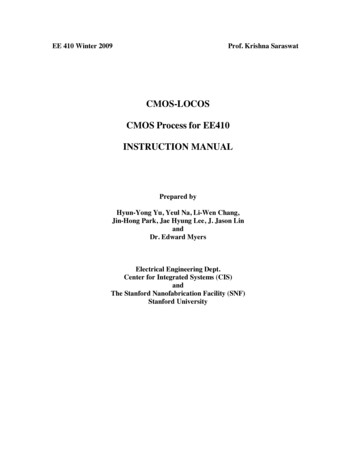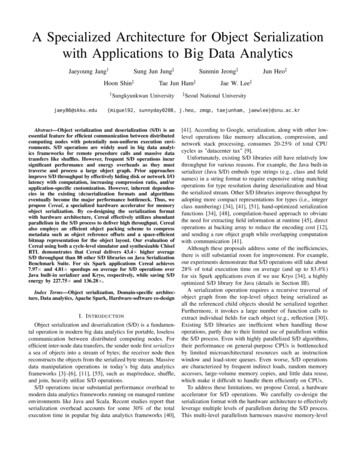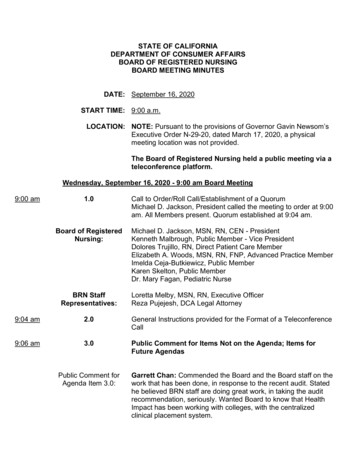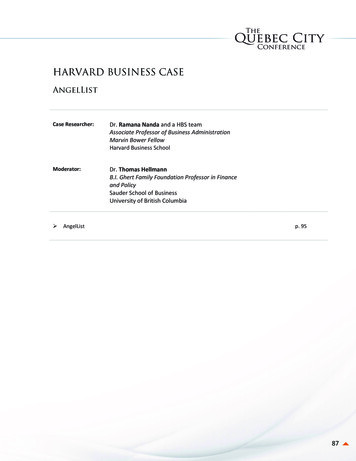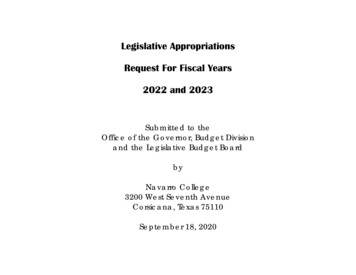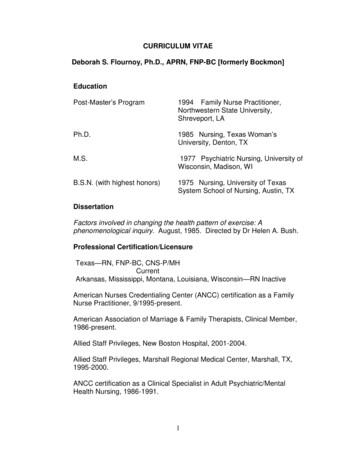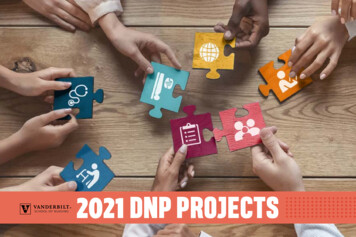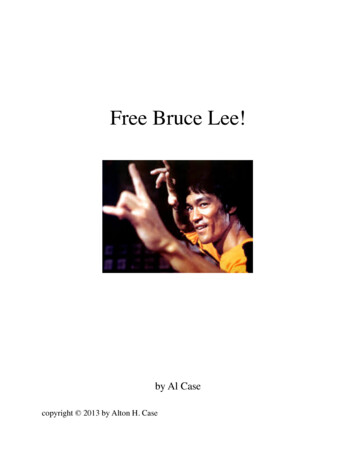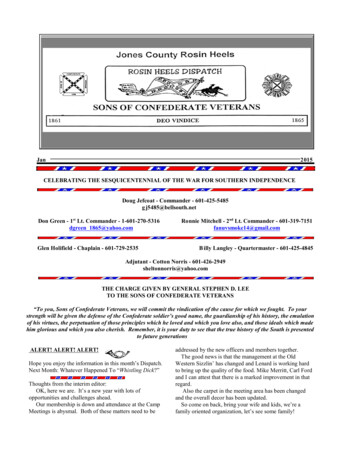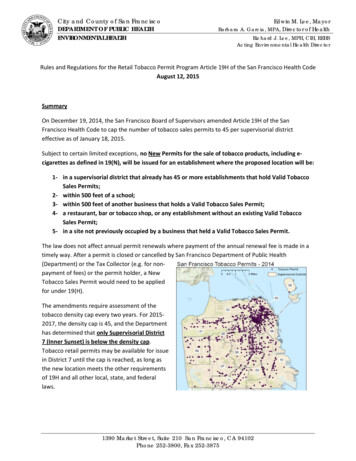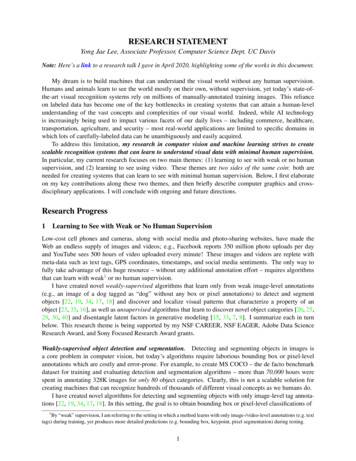
Transcription
RESEARCH STATEMENTYong Jae Lee, Associate Professor, Computer Science Dept. UC DavisNote: Here’s a link to a research talk I gave in April 2020, highlighting some of the works in this document.My dream is to build machines that can understand the visual world without any human supervision.Humans and animals learn to see the world mostly on their own, without supervision, yet today’s state-ofthe-art visual recognition systems rely on millions of manually-annotated training images. This relianceon labeled data has become one of the key bottlenecks in creating systems that can attain a human-levelunderstanding of the vast concepts and complexities of our visual world. Indeed, while AI technologyis increasingly being used to impact various facets of our daily lives – including commerce, healthcare,transportation, agriculture, and security – most real-world applications are limited to specific domains inwhich lots of carefully-labeled data can be unambiguously and easily acquired.To address this limitation, my research in computer vision and machine learning strives to createscalable recognition systems that can learn to understand visual data with minimal human supervision.In particular, my current research focuses on two main themes: (1) learning to see with weak or no humansupervision, and (2) learning to see using video. These themes are two sides of the same coin: both areneeded for creating systems that can learn to see with minimal human supervision. Below, I first elaborateon my key contributions along these two themes, and then briefly describe computer graphics and crossdisciplinary applications. I will conclude with ongoing and future directions.Research Progress1Learning to See with Weak or No Human SupervisionLow-cost cell phones and cameras, along with social media and photo-sharing websites, have made theWeb an endless supply of images and videos; e.g., Facebook reports 350 million photo uploads per dayand YouTube sees 500 hours of video uploaded every minute! These images and videos are replete withmeta-data such as text tags, GPS coordinates, timestamps, and social media sentiments. The only way tofully take advantage of this huge resource – without any additional annotation effort – requires algorithmsthat can learn with weak1 or no human supervision.I have created novel weakly-supervised algorithms that learn only from weak image-level annotations(e.g., an image of a dog tagged as “dog” without any box or pixel annotations) to detect and segmentobjects [22, 19, 34, 17, 18] and discover and localize visual patterns that characterize a property of anobject [23, 35, 16], as well as unsupervised algorithms that learn to discover novel object categories [26, 25,29, 30, 40] and disentangle latent factors in generative modeling [15, 33, 7, 8]. I summarize each in turnbelow. This research theme is being supported by my NSF CAREER, NSF EAGER, Adobe Data ScienceResearch Award, and Sony Focused Research Award grants.Weakly-supervised object detection and segmentation. Detecting and segmenting objects in images isa core problem in computer vision, but today’s algorithms require laborious bounding box or pixel-levelannotations which are costly and error-prone. For example, to create MS COCO – the de facto benchmarkdataset for training and evaluating detection and segmentation algorithms – more than 70,000 hours werespent in annotating 328K images for only 80 object categories. Clearly, this is not a scalable solution forcreating machines that can recognize hundreds of thousands of different visual concepts as we humans do.I have created novel algorithms for detecting and segmenting objects with only image-level tag annotations [22, 19, 34, 17, 18]. In this setting, the goal is to obtain bounding box or pixel-level classifications of1By “weak” supervision, I am referring to the setting in which a method learns with only image-/video-level annotations (e.g. texttags) during training, yet produces more detailed predictions (e.g. bounding box, keypoint, pixel segmentation) during testing.1
objects given only image-level labels. I am particularly excited about our recent Hideand-Seek approach [17], which is a surprisingly simple yet highly-effective solution.The key idea is simple: randomly hide image patches in the training images whenlearning an image classification model. This forces the model to focus on the different(randomly) retained object parts across the training images, which leads to the modellearning to localize the entire object (e.g., the entire dog) as opposed to prior methodswhich focus only on the most discriminative part (e.g., dog’s face). This idea hasalso proven to be useful as a data augmentation technique for training deep networks,improving the state-of-the-art on a variety of tasks including image classification,segmentation, face recognition, and person re-identification [20].Weakly-supervised visual data mining. Apart from scalability, weakly-supervisedlearning addresses another important issue: for abstract visual concepts like “whatmakes an antique car look antique?” or “what makes this shoe more comfortable thanthis other one?”, it is often ambiguous to know exactly what to label in the image.For example, given an image of an antique car, it can be difficult to precisely annotate at the pixel-level all regions of the car that make it look antique. My researchhas provided some critical first steps in addressing this difficulty by automaticallydiscovering such visual concepts in a data-driven way – by mining patches that arecorrelated with the weak image labels (e.g., the year that the cars were made; seeFigure on right) [23, 35, 16] – as well as by leveraging external knowledge bases andimage captions for weakly-supervised object detection and segmentation [34, 14]. Forthe latter, by leveraging common-sense cues derived from knowledge bases, my algorithms significantly improve upon prior methods that only rely on visual information.Unsupervised and self-supervised learning. Weakly-supervised learning does notfully address the scalability issue of visual recognition systems, as it still requiresannotations (albeit weak). Ultimately, the holy grail in computer vision is to createrecognition systems that can learn without any annotations. My research has madefundamental contributions to unsupervised object category learning (“discovery”), inparticular with the ideas of self-paced category discovery [29] in which objects arelearned in order of predicted difficulty, and context-aware category discovery [27, 30]in which the growing pool of learned categories serve as context to help discover newunknown categories. These ideas have inspired a large number of work not only indiscovery, but also in object detection, image segmentation, and unsupervised representation learning. Finally, I am very excited about our recent works on generativemodeling, FineGAN [15] and MixNMatch [7], which are among the first unsupervised methods to yield a structured, disentangled representation of background, objectshape, color/texture, and pose for image generation. Building on this work, I recentlydeveloped a novel unsupervised generative model for learning disentangled representations in class-imbalanced data [8], which better reflects real-world distributions.2Learning to See using VideoAnother exciting direction that I have taken is training visual recognition systems withvideo. Video offers something that images cannot: it provides motion information,which facilitates visual recognition in human vision; e.g. the slithering of a snake orthe fluttering of a butterfly helps in their identification. However, research in criticalvision tasks such as general (non-human) object classification, detection, and segmentation in video have been significantly lagging compared to their image counterparts,2Full imageRandomly hide patchesHide-and-Seek [17] improves weaklysupervised object localization by randomly hiding patches in each trainingimage (bottom), which forces the imageclassifier to go beyond just the most discriminative part (top) and instead learnto focus on all parts of the object.192619471975Given historic car images, my algorithm in [23] automatically discoversvisual elements (yellow, green boxes)whose appearance variations capturethe changes in car style across time.FineGAN [15] is a generative modelthat learns to hierarchically disentangle the background, object’s shape, andobject’s texture/color for image generation without any mask or object labelsupervision.
largely due to the huge annotation costs and hardware requirements that video demands. Given our dynamic visual world, I contend that these traditional image-basedtasks need to be studied with videos, especially since motion is an indispensable cue(that comes for free!) for learning to see. Undoubtedly, video will play a critical rolein creating machines that learn to see with minimal human supervision.I have created novel algorithms that segment and detect objects [28, 19, 36, 37]in video as well as algorithms that summarize videos captured from a wearable camera [24, 31, 4]. This research theme is being supported by my Army Research OfficeYoung Investigator Program (ARO YIP), NSF IIS RI Core, and AWS Machine Learning Research Award grants.Video object segmentation and detection. My Keysegments work on unsupervisedvideo foreground object segmentation [28] was one of the first to introduce the problem (prior methods required human annotation or segmented out all objects withoutidentifying the foreground ones), and showed how appearance and motion saliencycan be used to discover prototype instances of the foreground objects. My follow-upTrack-and-Segment paper [36] showed that self-paced learning can facilitate unsupervised video object segmentation; i.e., by focusing on the easiest frames for initialization, and incrementally updating the segmentation model using new (harder) instancesthat are discovered and segmented. More recently, I introduced an approach that provides spatio-temporal alignment of the latent memory in recurrent neural networksfor supervised video object detection [37]. By aligning the stored visual representation (memory) over time, more accurate spatially-localized visual features can beproduced for each object in each video frame. I am currently working towards unsupervised video recognition methods that exploit such spatio-temporal alignment.First-person “egocentric” video summarization and analysis. I created the firstapproach that predicts important objects to summarize hours-long egocentric videoscaptured from a wearable camera (e.g., GoPro) [24, 31]. Egocentric videos offer afirst-person view of the world (e.g., we can often see the camera wearer’s hands),and can be used to record the daily lives of the user – which is especially valuablefor people with memory loss as they provide visual cues to spark back memory. Thefirst-person view also translates naturally to robotics applications and enables a fruitful platform for embodied vision research in which agents learn to perceive and actthrough interaction with their environment. In recent work, together with IndianaUniversity collaborators, I created an algorithm that identifies the first-person camerawearer in a third-person (environmental) video that captures the scene [4]. This workis one of the first to combine information from both first- and third-person videos,which is a setting that is more likely to become common as environmental and wearable cameras become even more ubiquitous. I am excited to continue exploring newquestions and solutions in this novel research space.3Computer Graphics and Cross-Disciplinary ApplicationsI enjoy applying my vision and learning algorithms in creative ways. For computergraphics, I have created two novel systems (both published in SIGGRAPH): ShadowDraw [32] and AverageExplorer [41]. ShadowDraw is a real-time interactive systemthat guides the freeform drawing of objects on a PC tablet – it automatically retrievesand blends images that match the user’s ongoing drawing from a large image database.3Keysegments [28] and Track-andSegment [36] are unsupervised videoobject segmentation approaches thatautomatically identify and segment theforeground objects in unlabeled RoI PoolingClassBoxregSpatial-Temporal Memory Networks [37] perform video objectdetection by learning to model andspatially-align an object’s long-termtemporal appearance and motiondynamics.[1:53 pm][3:11 pm][1:23 pm][6:55 pm][7:02 pm]My first-person video summarizationalgorithm [24, 31] produces keyframesummaries focused on the automatically predicted important people andobjects that the camera wearer interacted with.
AverageExplorer is a real-time interactive system that allows a user to rapidly exploreand visualize a large image collection using the medium of average images.Being at UC Davis, I have had the opportunity to collaborate with world-classVeterinary Medicine and Animal Science researchers. I took upon this opportunity toexplore two problems: (1) understanding rodent behavior [11], and (2) decoding painin livestock animals, which involves automatically detecting keypoints (e.g., eyes,nose, mouth) on their faces [10]. The latter is a large project, for which I receivedthe Hellman Fellowship Award, that involves collaborators in the UC Davis Centerfor Equine Health, Animal Science, Swedish Agricultural University, and UCSD.Together with collaborators in the ECE department, I have also worked on analyzingthe adoption and propagation of content (e.g., images) in online social networks [9, 6].ShadowDrawAverageExplorerShadowDraw [32] (top) and AverageExplorer [41] (bottom) are real-timeinteractive systems for freeform drawing and image exploration, respectively.Ongoing and Future DirectionsTo summarize, my research in computer vision and machine learning focuses on algorithms that learn to understand visual data with weak or no human supervision, andby leveraging motion and temporal cues in video. In addition to these themes, I aminterested in all other challenges that need to be addressed in creating machinesthat can attain a human-level understanding of the visual world. Specifically, I aminterested in exploring questions such as: Can we develop perception algorithms that can learn from multiple modalities? We humans learn about our world through signals acquired from multiplesources (e.g., sound, vision, smell, touch, taste), which often supervise eachother. However, until very recently, computer vision research has largely focused only on utilizing visual data. I believe that multi-modal learning will beespecially critical for creating systems that can learn without human annotations. I have begun to make progress in this direction [34, 14, 39, 12, 38]. Can we create algorithms that can dynamically adapt to changing environments? While most existing visual scene understanding research assumes afixed and static environment, this assumption does not hold in many real-worldscenarios. Instead, robust and fast algorithms that can adapt online to constantly changing environments are needed. Our recent work on real-time instance segmentation YOLACT [1, 2] takes a step towards this direction. How can we create unbiased and secure visual recognition algorithms? Ascomputer vision technology is becoming more integrated into our daily lives,addressing ethical, bias/fairness, and privacy/security questions are more important than ever. I have begun to study ways to ensure the privacy and securityof users in the visual data that the algorithms process [13, 5, 3], to mitigateundesirable biases [21], and to improve robustness of deep networks [42]. Inparticular, [42] proposed a novel anti-aliasing module for convolutional networks, and received the best paper award at BMVC 2020.Over the next decades, I will strive to continue to be on the forefront in creatingmachines that can learn with minimal human supervision. I am passionate about asking the right (meaningful and impactful) research questions, and proposing innovativeand effective solutions to those questions. I am excited about the prospects of workingtowards these challenges with collaborators in vision and learning, and related fieldsincluding graphics, robotics, neuroscience, and cognitive science.4YOLACT [1] is the first real-time(above 30 FPS) instance segmentation approach with competitive instancesegmentation accuracy on the challenging MS COCO dataset.Original videoIdentity: JessicaAction: Applying make-up on lipsAnonymized videoIdentity: ?Action: Applying make-up on lipsOur privacy-preserving action detector [13] learns to modify video framesto anonymize a person’s face (so thatJessica is no longer identifiable), whilepreserving action information (puttingon lipstick).
References[1] D. Bolya, C. Zhou, F. Xiao, and Yong Jae Lee. YOLACT: Real-time Instance Segmentation. In IEEE International Conference on ComputerVision (ICCV), 2019. (oral presentation).[2] D. Bolya, C. Zhou, F. Xiao, and Yong Jae Lee. YOLACT : Better Real-time Instance Segmentation. IEEE Transactions on Pattern Analysisand Machine Intelligence (TPAMI), 2020.[3] Z. A. Din, H. Venugopalan, J. Park, A. Li, W. Yin, H. Mai, Yong Jae Lee, S. Liu, and S. T. King. Boxer: Preventing Fraud by ScanningCredit Cards. In USENIX Security Symposium (USENIX Security), 2020.[4] C. Fan, J. Lee, M. Xu, K. Singh, Yong Jae Lee, D. Crandall, and M. Ryoo. Identifying First-Person Camera Wearers in Third-Person Videos.In IEEE Conference on Computer Vision and Pattern Recognition (CVPR), 2017.[5] X. Gu, W. Luo, M. Ryoo, and Yong Jae Lee. Password-conditioned Anonymization and Deanonymization with Face Identity Transformers.In European Conference on Computer Vision (ECCV), 2020.[6] W. Hu, K. Singh, F. Xiao, J. Han, C. Chuah, and Yong Jae Lee. Who Will Share My Image? Predicting the Content Diffusion Path in OnlineSocial Networks. In ACM International Conference on Web Search and Data Mining (WSDM), 2018.[7] Y. Li, K. K. Singh, U. Ojha, and Yong Jae Lee. MixNMatch: Multifactor Disentanglement and Encoding for Conditional Image Generation.In IEEE Conference on Computer Vision and Pattern Recognition (CVPR), 2020.[8] U. Ojha, K. K. Singh, C.-J. Hsieh, and Yong Jae Lee. Elastic-InfoGAN: Generative Modeling of Disentangled Representations in ClassImbalanced Data. In Neural Information Processing Systems (NeurIPS), 2020.[9] M. Rahman, J. Han, Yong Jae Lee, and C. Chuah. Analyzing the Adoption and Cascading Process of OSN-Based Gifting Applications: AnEmpirical Study. ACM Transactions on the Web (TWEB), 11(2), 2017.[10] M. Rashid, X. Gu, and Yong Jae Lee. Interspecies Knowledge Transfer for Facial Keypoint Detection. In IEEE Conference on ComputerVision and Pattern Recognition (CVPR), 2017.[11] Z. Ren, A. Noronha, A. V. Ciernia, and Yong Jae Lee. Who Moved My Cheese? Automatic Annotation of Rodent Behaviors with Convolutional Neural Networks. In IEEE Winter Conference on Applications of Computer Vision (WACV), 2017.[12] Z. Ren and Yong Jae Lee. Cross-Domain Self-supervised Multi-task Feature Learning using Synthetic Imagery. In IEEE Conference onComputer Vision and Pattern Recognition (CVPR), 2018.[13] Z. Ren, Yong Jae Lee, and M. Ryoo. Learning to Anonymize Faces for Privacy Preserving Action Detection. In European Conference onComputer Vision (ECCV), 2018.[14] K. Singh, S. Divvala, A. Farhadi, and Yong Jae Lee. DOCK: Detecting Objects by transferring Common-sense Knowledge. In EuropeanConference on Computer Vision (ECCV), 2018.[15] K. Singh, U. Ojha, and Yong Jae Lee. FineGAN: Unsupervised Hierarchical Disentanglement for Fine-Grained Object Generation andDiscovery. In IEEE Conference on Computer Vision and Pattern Recognition (CVPR), 2019. (oral presentation).[16] K. Singh and Yong Jae Lee. End-to-End Localization and Ranking for Relative Attributes. In European Conference on Computer Vision(ECCV), 2016.[17] K. Singh and Yong Jae Lee. Hide-and-Seek: Forcing a Network to be Meticulous for Weakly-supervised Object and Action Localization. InIEEE International Conference on Computer Vision (ICCV), 2017.[18] K. Singh and Yong Jae Lee. You reap what you sow: Using Videos to Generate High Precision Object Proposals for Weakly-supervisedObject Detection. In IEEE Conference on Computer Vision and Pattern Recognition (CVPR), 2019.[19] K. Singh, F. Xiao, and Yong Jae Lee. Track and Transfer: Watching Videos to Simulate Strong Human Supervision for Weakly-SupervisedObject Detection. In IEEE Conference on Computer Vision and Pattern Recognition (CVPR), 2016.[20] K. Singh, H. Yu, A. Sarmasi, G. Pradeep, and Yong Jae Lee. Hide-and-Seek: A Data Augmentation Technique for Weakly-SupervisedLocalization and Beyond. In arXiv, 2018.[21] K. K. Singh, D. Mahajan, K. Grauman, Yong Jae Lee, M. Feiszli, and D. Ghadiyaram. Don’t Judge an Object by Its Context: Learning toOvercome Contextual Bias. In IEEE Conference on Computer Vision and Pattern Recognition (CVPR), 2020. (oral presentation).[22] H. O. Song, Yong Jae Lee, S. Jegelka, and T. Darrell. Weakly-supervised Discovery of Visual Pattern Configurations. In Neural InformationProcessing Systems (NeurIPS), 2014.[23] Yong Jae Lee, A. A. Efros, and M. Hebert. Style-aware Mid-level Representation for Discovering Visual Connections in Space and Time. InIEEE International Conference on Computer Vision (ICCV), 2013. (oral presentation).[24] Yong Jae Lee, J. Ghosh, and K. Grauman. Discovering Important People and Objects for Egocentric Video Summarization. In IEEEConference on Computer Vision and Pattern Recognition (CVPR), 2012.[25] Yong Jae Lee and K. Grauman. Foreground Focus: Unsupervised Learning From Partially Matching Images. International Journal ofComputer Vision (IJCV), 85, 2009.[26] Yong Jae Lee and K. Grauman. Shape Discovery from Unlabeled Image Collections. In IEEE Conference on Computer Vision and PatternRecognition (CVPR), 2009.[27] Yong Jae Lee and K. Grauman. Object-Graphs for Context-Aware Category Discovery. In IEEE Conference on Computer Vision and PatternRecognition (CVPR), 2010. (oral presentation).[28] Yong Jae Lee and K. Grauman. Key-Segments for Video Object Segmentation. In IEEE International Conference on Computer Vision(ICCV), 2011.[29] Yong Jae Lee and K. Grauman. Learning the Easy Things First: Self-Paced Visual Category Discovery. In IEEE Conference on ComputerVision and Pattern Recognition (CVPR), 2011.[30] Yong Jae Lee and K. Grauman. Object-Graphs for Context-Aware Visual Category Discovery. IEEE Transactions on Pattern Analysis andMachine Intelligence (TPAMI), 34(2):346–358, 2012.[31] Yong Jae Lee and K. Grauman. Predicting Important Objects for Egocentric Video Summarization. International Journal of Computer Vision(IJCV), 114(1):38–55, 2015.[32] Yong Jae Lee, C. L. Zitnick, and M. Cohen. ShadowDraw: Real-Time User Guidance for Freehand Drawing. ACM Transactions on Graphics(Proceedings of SIGGRAPH), 30(4), 2011.[33] F. Xiao, H. Liu, and Yong Jae Lee. Identity from here, Pose from there: Self-supervised Disentanglement and Generation of Objects usingUnlabeled Videos. In IEEE International Conference on Computer Vision (ICCV), 2019.[34] F. Xiao, L. Sigal, and Yong Jae Lee. Weakly-supervised Visual Grounding of Phrases with Linguistic Structures. In IEEE Conference on
Computer Vision and Pattern Recognition (CVPR), 2017.[35] F. Xiao and Yong Jae Lee. Discovering the Spatial Extent of Relative Attributes. In IEEE International Conference on Computer Vision(ICCV), 2015. (oral presentation).[36] F. Xiao and Yong Jae Lee. Track and Segment: An Iterative Unsupervised Approach for Video Object Proposals. In IEEE Conference onComputer Vision and Pattern Recognition (CVPR), 2016. (spotlight presentation).[37] F. Xiao and Yong Jae Lee. Video Object Detection with an Aligned Spatial-Temporal Memory. In European Conference on Computer Vision(ECCV), 2018.[38] F. Xiao, Yong Jae Lee, K. Grauman, J. Malik, and C. Feichtenhofer. Audiovisual SlowFast Networks for Video Recognition. In arXiv, 2019.[39] M. Zhou, R. Cheng, Yong Jae Lee, and Z. Yu. A Visual Attention Grounding Neural Model for Multimodal Machine Translation. InConference on Empirical Methods in Natural Language Processing (EMNLP), 2018. (oral presentation).[40] T. Zhou, Yong Jae Lee, S. Yu, and A. A. Efros. FlowWeb: Joint Image Set Alignment by Weaving Consistent, Pixel-wise Correspondences.In IEEE Conference on Computer Vision and Pattern Recognition (CVPR), 2015. (oral presentation).[41] J.-Y. Zhu, Yong Jae Lee, and A. A. Efros. AverageExplorer: Interactive Exploration and Alignment of Visual Data Collections. ACMTransactions on Graphics (Proceedings of SIGGRAPH), 33(4), 2014.[42] X. Zou, F. Xiao, Z. Yu, and Yong Jae Lee. Delving Deeper into Anti-aliasing in ConvNets. In British Machine Vision Conference (BMVC),2020. (Best Paper Award).
tate at the pixel-level all regions of the car that make it look antique. My research has provided some critical first steps in addressing this difficulty by automatically discovering such visual concepts in a data-driven way – by mining patches that are correlated with the weak

